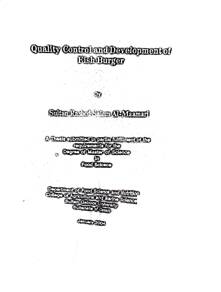Document
Quality control and development of fish burger.
Publisher
Sultan Qaboos University
Gregorian
2004
Language
English
Subject
English abstract
يشكل المخزون السمكي للسلطنة المصدر الرئيسي للدخل بعد النفط، وهو أهم الموارد الطبيعية المتجددة. لكنه غير مستغل بالشكل الأمثل. فهناك نسبة من الأسماك المصادة تصدر إلى الخارج ولكن جودة هذه الأسماك تمثل مشكلة خطيرة. وهذا يحدث في وقت يتزايد فيه الطلب للموارد البحرية محليا وبالخارج. ومن ناحية أخرى، فأن تطوير المنتجات السمكية ما يزال في بداياته، ولهذا فإنه من الأحرى بشركات الأسماك المحلية أن تسعى إلى تطوير المنتجات السمكية لكي توسع من مبيعاتها وتحقق النمو المتكامل.
أن هدف هذا المشروع هو التطوير الهادف لبرجر السمك والذي ينبغي أن يأخذ في عين الاعتبار طلب السوق المحلي والخارج ووفرة أسماك ذات جودة جيدة و تكلفة المواد الخام والتحكم في الجودة والفعالية في عمليات التصنيع. إن المواد الخام السمكية يتم اختيارها على أساس اللون والخواص البنائية للبروتينات أو التكلفة المبدئية المنخفضة لهذه المواد الخام. إن برجر السمك صمم وحضر مع الأخذ في الاعتبار المعايير السالفة الذكر للمواد الخام خصائص التشوه الكبيرة لهذه اللحوم عرفت باستخدام اختبار الضغط و صفات معينة قورنت بالقبول الكلي للمنتج على أساس طريقة صاعدة خاصة بمذهب المتعة.
برجر السمك التقليدي يعمل غالبا بالنشا الإضافية لكنها تفشل في مقابلة توقعات المستهلك الأكل الميزات الممتازة . لكن الصياغات المحسنة يمكن أن تعرض منصبا جديدا للتسويق في منطقة منتجات السمك المصنعة . المكونات العملية المبشرة التي يمكن إن تحسن الخصائص الحسية تتضمن بروتين اللبن و البكتين الحمضي و الجيلاتين البقري . جودة اللحوم أسئلت أكثر بتقديم مكونات إضافية للصياغة، على سبيل المثال بروتين الصويا، كسكاريدجينان، الخضر و الفواكه المجقفة المجمدة .
قفزات علوية و سفلية مميزة من قيم الصعوبة (Hardness)، الثبات (Firmness) ، اللصاقه (Adhesiveness) و النسبة من نقطة الانكسار إلى التوتر الأقصى (stress ratio) عرفت بالعلاقة مع قبول حستي افضل المنتج .
Member of
Resource URL
Arabic abstract
The rich and diverse fish stocks of Oman, the main source of wealth after oil, are the most important long-term renewable resource. However, they are not fully utilized. A . proportion of the fish harvest is exported, but fish quality represents a serious problem
for export. This happens at a time of increasing demand for marine resources both locally and abroad. Fish product development in the local industry is in its infancy, but it is necessary for manufacturing companies to develop fish products in order to expand sales and achieve organic growth.
The aim of the project is the purposeful development of fish burgers, which should take into consideration the demand of the local market and abroad, availability of good quality fish, cost of raw materials, quality control and effectiveness of processing. Fish source has been identified based on the color and structural properties of the protein or the low market value of the raw material. Fish burger have been designed and preparations made taking into account the aforementioned criteria for the raw material.
In methodology, the large deformation properties of these burgers were identified using compression testing, and specific attributes were handshaken with the overall acceptability of the product on the basis of a hedonic scaling method.
Traditional fish burgers are made mostly with added. starch but fail to meet consumer expectations of eating quality characteristics. Improved formulations, however, can offer a new marketing position in the area of processed fish products. Promising functional ingredients that can improve organoleptic properties include milk protein, citrus pectin and bovine gelatin. The quality of the burgers was further manipulated by introducing additional ingredients to the formulation, e.g. soya protein, K-carrageenan, frozen vegetables and dried fruits.
In conclusion, distinctive upper and lower bounds of the values of hardness,
firmness, adhesiveness and the ratio of inflectional to maximum stress were defined in relation to optimum sensory acceptability of the product.
for export. This happens at a time of increasing demand for marine resources both locally and abroad. Fish product development in the local industry is in its infancy, but it is necessary for manufacturing companies to develop fish products in order to expand sales and achieve organic growth.
The aim of the project is the purposeful development of fish burgers, which should take into consideration the demand of the local market and abroad, availability of good quality fish, cost of raw materials, quality control and effectiveness of processing. Fish source has been identified based on the color and structural properties of the protein or the low market value of the raw material. Fish burger have been designed and preparations made taking into account the aforementioned criteria for the raw material.
In methodology, the large deformation properties of these burgers were identified using compression testing, and specific attributes were handshaken with the overall acceptability of the product on the basis of a hedonic scaling method.
Traditional fish burgers are made mostly with added. starch but fail to meet consumer expectations of eating quality characteristics. Improved formulations, however, can offer a new marketing position in the area of processed fish products. Promising functional ingredients that can improve organoleptic properties include milk protein, citrus pectin and bovine gelatin. The quality of the burgers was further manipulated by introducing additional ingredients to the formulation, e.g. soya protein, K-carrageenan, frozen vegetables and dried fruits.
In conclusion, distinctive upper and lower bounds of the values of hardness,
firmness, adhesiveness and the ratio of inflectional to maximum stress were defined in relation to optimum sensory acceptability of the product.
Category
Theses and Dissertations

